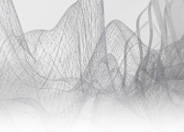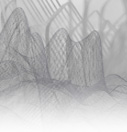Interview of June 2020 - 3D Imperial Magazine - China.
Gilles Azzaro
Born in Casablanca
French digital artist, sound sculptor, drummer.
Member of the first Fablab in France.
His work focuses mainly on three-dimensional sound reproduction and materialization.
Graduated from the Second University of Toulouse

Gilles AZZARO
Photo Alexandre Ollier
For many people and even for people in the industry, the concept of 3D sound printing "is very strange, because It is difficult for us to imagine that sound can be printed. Of course, we are also full of doubts , this is how the sound is printed? From 2018, "3D Imperial" exclusively interviewed French digital artist and sound sculptor Gilles Azzaro with these questions, and he explained to us the understanding of 3D sound printing.
At that time, Gilles Azzaro caused a sensation all over the world with his work "NEXT INDUSTRIAL REVOLUTION", and even personally presented 3D printed sound works at the White House, and was received by former American President Barack Obama .
At that time, Azzaro's works mainly transmitted peace and good aspiration to the world in the name of love. Now Azzaro has brought in their brand new work, which contains different concepts from previous work.
This issue of 3D Imperial takes you into the world of sound 3D printing by the voice sculptor, to understand how Gilles Azzaro can visualize invisible things and give them a tangible image.

Next Industrial Revolution
Photo Gilles Azzaro
For now, 3D printing technique is the best option to make the voices to be visible and tangible. Do you agree with this idea? And why?
Before answering I would like to say how honoured I am to be the first artist to have two interviews published in 3D Imperial.
What you say is partly right. But there is not only one truth. When I first started looking into making voices tangible I didn't know much about digital technologies and also I didn't have the equipment at the time, and to outsource the creation of a prototype would have been too expensive.
Creating France's first Fablab along with a group of friends gave me access to 3D printing machines which enabled the creation of my first ever printed artwork; “Barack Obama – Next Industrial Revolution”.
Although it was very long to make (350 hours' printing which was a record at the time), and was made in 11 individual parts, 3D printing became my choice tool.
I don't regret this is any way since 3D printing meant I could come up with a visual appearance no other technology can provide.
Note: The Innovation Lab, also known as Fablab, is a new lab created by the MIT Bit and Atomic Research Center - a lab that can make almost any Small Factory product and tool. Right now, human beings are at the dawn of the third digital revolution. In this revolution where "personal manufacturing" is at the heart, materials technology and information technology have already shown signs. Fab Labs is the wave that is ahead of the coming revolution.
Next industrial revolution: on February 12, 2013, at the US Federal Congress, former US President Barack Obama delivered a State of the Union address, devoted to the development and creation of a new Fablab, while promoting the development of 3D printing technology.
Gilles Azzaro converted the audio speech into a 3D printed sculpture and named the work Next Industrial Revolution.

What is Fablab ?
Photo Kerry GAMON
Every coin has two sides. In a rational way, what is your opinion about the differences between 3D printing and traditional techniques? Will you apply traditional techniques to sculpt voices?
It all depends on the approach you have to creation. In fact your question is extremely complex. To answer, just imagine having to create a voice in three-dimensions without using any existing new technologies, all you have is a pencil and a hand saw!
For the 3-dimensional modelling of a voice print:
First the audio files are created in 3D using a software program I developed and am the only person to use. To do this manually is simply impossible except if you choose to track only the key points that make up the sound. A sound modelled manually would be almost inaudible and it would only give an extremely basic representation of what the sound could look like.
To pinpoint all the coordinates of a 3-dimensional image (similar to a three-dimensional computer file) would be incredibly difficult. There are thousands, or millions of points that need to be correctly positioned and connected up. And this is only for the modelling part.
With the production, the problem of accuracy would be the same. It would be extremely difficult to reproduce a sound recording in three dimensions with the same quality and sonority. With a hand saw, the cuts would remain approximative, however hard you try. The aesthetic result might look something like the original 3D image but it would not have the precision and accuracy I can obtain using digital equipment.
You spent 6 years on developing the Macrogroove. During the developing process, what impressed you most? Or what is the most difficult part during the process?
Correct, and now we are entering my seventh year of research!
Designing and developing Macrogroove is one of the most significant explorations I have undertaken. It involves making the impossible possible.
To print recordings in 3D is already quite a feat and it took me a number of years to get there, but I only had the physical shape.
I then had to discover how to read the print and bring out the sound contained within. That is now possible.

MACROGROOVE
Photo Shannon Aouatah
I usually work alone when creating my artwork but seeing how complex this was I had to create a team of experts to help me. The REVA department of the IRIT in Toulouse, France houses expert faculty, research scientists and students. The team members are Paul Chable/Yvain Quéau/Axel Carlier/Jean Mélou /Matthieu Pizenberg/Thomas Forgione, led by Jean-Denis Durou.
We spent six years exploring the possibilities to find a way to transform the printed data into exploitable data and extract the sound it contains.
We developed a number of prototypes. We changed the coding but that modified the visual appearance of the sound prints and wasn't always to my liking. We also tested different sound acquisition techniques using 3D scanners.
We imagined and tried out all possible scenarios without ever losing faith or sight of our primary objective. Our starting point was simple : how to extract from a three-dimensional print of a coded sound all the data it contains to be able to listen to them without even the slightest loss in quality.
We got it wrong many times, but this enabled us to narrow down our research and finally find a solution : making the data physical then transforming the physical back into data. Visible, audible 3D sound in a solid and tangible state.
For Macrogroove, we didn't modify my initial three-dimensional prints as they already contained all the data necessary for quality audio reproduction. When I started out working on the project, I knew that one day I would find a way to hear what I had printed!
The REVA team proved wrong a great many private and faculty research laboratories I contacted and who announced it was simply not possible.
Personally, the most impressive thing is the energy, the tenacity and ingenuity of the REVA team. They pushed their intelligence and mathematical skills and expertise to places others didn't even know existed while listening to and taking into consideration my whims as an artist!
I know I didn't make life easy for them by reminding them at each meeting we had that it was above all a work of art we were working on, but we succeeded and ended up with exactly what I was after.
However, although Macrogroove could be seen as a finished work of art, it can be perfected even further and I see it as a draft of something even better.
Now that we know how to proceed we are already working on something that will be very different from Macrogroove, something that can overcome one of the major constraints of 3D printed sound …. Time, for much longer recordings!
As a voice sculptor, have you ever consider 3D printing a video with sound? If yes, could you please kindly share your plans with us?
While we were developing my Macrogroove, I suggested that with our research at the stage it was at, why not imagine a work that could read not only sound but also videos with sound.
Since a video is easier to code and decode because the number of images per second is always the same, we simply applied the coding I have been using for a few years now and it worked! And Macrogroove was the player! We regularly add new functions to it, if, for me, there is a meaning behind it, not technological, more philosophical.
3D printed video with sound will be the basis of a new work, based on the content of the printed video itself. Imagine a multimedia library printed in 3D and that continuously updates as time goes by! This isn't technology talking, this is about what the work means and says.

MACROGROOVE
Photo Shannon Aouatah
Some people consider all the 3D printed projects just gimmicks or stunts. Some people think there in only technology in the 3D printing works. While your amazing projects always starts from philosophical and spiritual reflections. For your latest stunning projects Armstrong and Macrogroove, where do you get your inspirations from?
Basically, 3D printing is a new production tool that can be used almost everywhere and by everyone. From a DIY guy to a professional, to produce decorative objects or sophisticated mechanical components.
Some artists, including myself, recognised this as a new form of expression, offering new creative opportunities.
My personal vision is that an artist should look for more than just an aesthetic result. Works of art need to convey a message. Words, thought, sensitivity, emotions to share with the public. There are so many different ways to talk about something – more than there are languages on earth. Everyone can find the one that is best for them and communicate with the whole world.
Personally, I assume that the most important is invisible, an invisible that can be experienced through emotions – inner emotions – and that this is much more important than limiting ourselves to what we see. We need to go beyond this, deep inside.

NEIL ARMSTRONG (FLY ME TO THE MOON)
Photo Shannon Aouatah
How do you come up with the idea of sending your sculpture (Armstrong) to the moon? What does the moon or the moon landing means to you?
When the FabFoundation asked me to think about creating works to celebrate the 50th anniversary of the first man on the moon, I immediately felt it was important to pay a tribute to these pioneers.
The idea I came up with was to return Neil Armstrong's soul to the moon. I am sure for him this would have seemed the perfect resting place. I designed this spatial work for the NASA. I wanted to send my sculpture to the moon's surface, in a place known as The Sea of Tranquility (exactly where the Eagle lunar module landed in 1969).
This would have been extremely symbolic, linking space technology to memory, to the history of mankind. In order to enhance this link, between the Earth and Moon, I devised a system to enable people to interact with the sculpture via their smartphones … and hear Neil Armstrong's voice pronouncing the famous words “One small step for man, one giant leap for mankind” coming down from out in space.
240,000 miles in just a few seconds. With this creation, Neil Armstrong, who has left this world, would be physically invisible but thanks to his Voice, very much alive. Unfortunately, for various reasons this project never got off the ground, but that's ok, I like to think I imagined what Neil Armstrong would have wanted.
The moon itself means a lot to me.
It's not dark, indeed it's quite the opposite. Remember it's the moon that gives us light when all is dark.
For me the moon is like a second sun, an intriguing and wonderful source of light and inspiration.
We are close enough to be connected. We are inseparable.
Everything in this universe is based on pairs, and there is no need to separate a finely balanced pair. The earth and moon are not opposites, they are complementary, they are one.
Do you have any future plans please? Or what projects are you currently working with? There are so many! Some are just ideas, others fairly advanced already, but also extremely complex.
Others are very different from what I have done in the past. Nothing to do with sound, or voice, or video, but always connected to the invisible. Observe what you feel, feel what is invisible around you.
Personally I have felt something, something living. I am in the process of exploring how to extract these three-dimensional images using mathematics. This new direction is just as lyrical as what I am doing at the moment, but the approach is different.. something you know but have never seen.
The Editor:
How to define the charm of 3D printing? The most powerful expression is to transform invisible sound into visible things. Under the work of Gilles Azzaro, we see more possibilities offered by new technologies.
Compared to traditional crafts, the creation of a new thought is more tangible and turned towards the future. When the interesting and thinking meet an innovative technology, maybe all the intangible assets will end up becoming a beautiful existence.
Claire Jiang @ 3D Imperial / Kris Tsui @ 3D Imperial |






